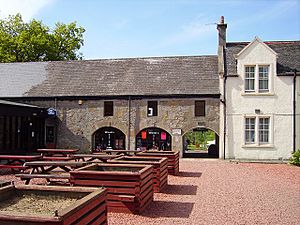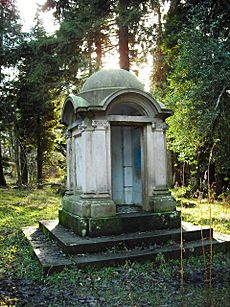Polkemmet Country Park facts for kids
Polkemmet Country Park is a fun place to visit in West Lothian, Scotland. It's about 2 kilometers west of Whitburn and is a 3-star visitor attraction. You can find it right next to the M8 motorway, near the "Heart of Scotland" services at Harthill. This park was created on the land of an old country house called Polkemmet House, which was taken down in the 1960s. The local council bought the land in 1978, and the park opened to everyone in 1981. Polkemmet Country Park is quite big, covering 169 hectares, and West Lothian Council looks after it.
Contents
The Park's Story: From Home to Park
The Polkemmet estate has a long history. A family named Baillie bought the land in 1620 and built a large country house there. In 1823, William Baillie became a baronet, which is a special title, and he made the house even bigger. The Baillie family owned Polkemmet House until the 1950s. However, from the 1930s, no one lived in it because Sir Adrian Baillie, the 6th Baronet, moved to Leeds Castle in England.
Polkemmet House During World War II
During the Second World War, Polkemmet House was used for important war efforts. It became a hospital for soldiers and a place for Polish soldiers to stay. These soldiers had escaped from Poland when it was taken over by the Nazis and came to fight for Britain. Sir Adrian Baillie passed away in 1947 and was buried in a special tomb, called a mausoleum, on the estate.
After the War: A School and Police College
After the war, Polkemmet House became a Trefoil School, run by the Girl Guides movement. Princess Elizabeth, who is now the Queen, officially opened the school on September 25, 1945. She later became a supporter of the school. In 1951, the Trefoil School moved to a new location.
From 1951 to 1960, Polkemmet House was used by the Scottish Police College. This is where police officers learned their skills. In 1960, the college moved to Tulliallan Castle. After that, the house and its land were sold to the National Coal Board (NCB). The NCB was a company that dug for coal in big open mines nearby.
The House is Demolished
Polkemmet House was a two-story building built in the Scots Baronial style. This means it looked like an old Scottish castle. It had been rebuilt and made bigger several times, but its core was still the 17th-century mansion. Sadly, the house was taken down in the 1960s.
However, some parts of the old estate still stand! The stable block, which had stables for horses, rooms for staff, and places for carriages, is still there. Three of the original staff houses are still lived in today. The only other part of the park not owned by the council is the area around the Baillie family mausoleum.
In 1978, West Lothian District Council bought the Polkemmet House estate for £70,000. They got a grant to help pay for it. The old stable block was turned into visitor facilities and offices for staff. A golf course was also built on the grounds. The park officially opened to the public on June 26, 1981.
What Can You Do at Polkemmet Park?
The River Almond, one of West Lothian's main rivers, flows through Polkemmet Country Park. It starts near Harthill and winds its way through the park.
Activities and Facilities
A large part of the park has a golf course and a driving range where you can practice your golf swing. But there are also many areas with trees and walking paths. You can enjoy a nice walk through the old estate.
Other things to do at the park include:
- A bowling green
- Picnic areas
- A children's play area
- Car parking
The old stable and office buildings now have a cafe, the golf course office and shop, maintenance facilities, and public toilets. There's even a barbecue area where the old tennis courts used to be.
Nature and Wildlife
The park has many different kinds of trees. Some of the special trees have signs that tell you what kind they are and their history. The park is open all year round, so you can visit anytime! Since 2012, the park has also been home to the Scottish Owl Centre, where you can see amazing owls.
The Horn Sculpture
"The Horn" is a very tall sculpture, about 24 meters high. It's located at one corner of the park, right next to the M8 motorway. This shiny stainless steel sculpture was designed by artists Matthew Dalziel and Louise Scullion. It was officially shown to the public on November 21, 1997. On windy days, "The Horn" can even play recorded music, poetry, and famous quotes!





